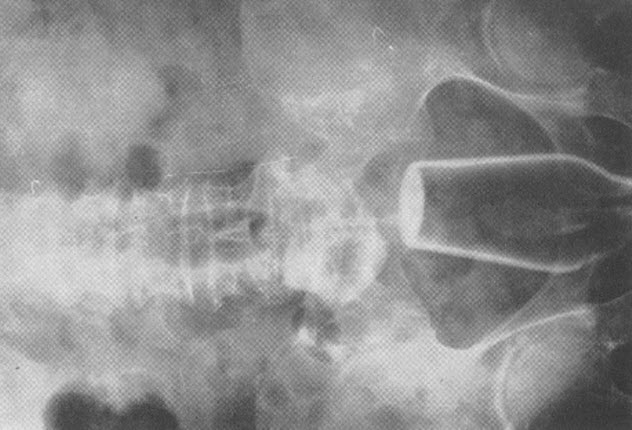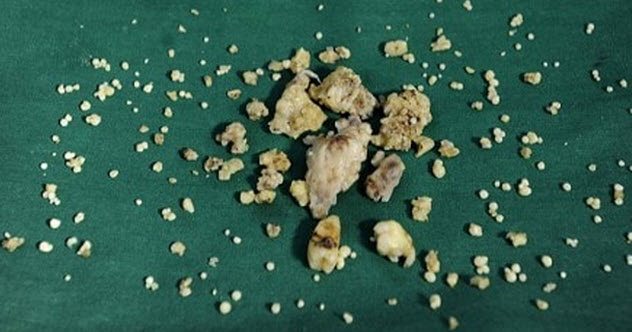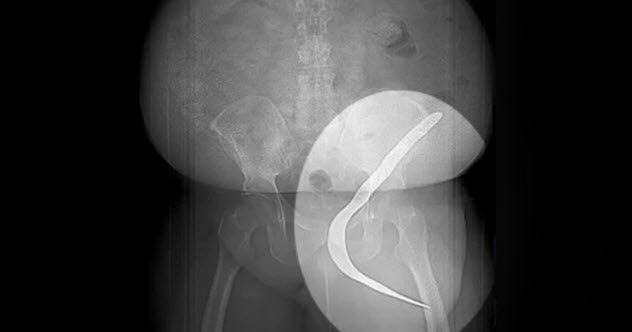 Our World
Our World  Our World
Our World  Pop Culture
Pop Culture 10 Incredible Female Comic Book Artists
 Crime
Crime 10 Terrifying Serial Killers from Centuries Ago
 Technology
Technology 10 Hilariously Over-Engineered Solutions to Simple Problems
 Miscellaneous
Miscellaneous 10 Ironic News Stories Straight out of an Alanis Morissette Song
 Politics
Politics 10 Lesser-Known Far-Right Groups of the 21st Century
 History
History Ten Revealing Facts about Daily Domestic Life in the Old West
 Weird Stuff
Weird Stuff 10 Everyday Products Surprisingly Made by Inmates
 Movies and TV
Movies and TV 10 Actors Dragged out of Retirement for One Key Role
 Creepy
Creepy 10 Lesser-Known Shapeshifter Legends from Around the World
 Our World
Our World 10 Science Facts That Will Change How You Look at the World
 Pop Culture
Pop Culture 10 Incredible Female Comic Book Artists
 Crime
Crime 10 Terrifying Serial Killers from Centuries Ago
Who's Behind Listverse?

Jamie Frater
Head Editor
Jamie founded Listverse due to an insatiable desire to share fascinating, obscure, and bizarre facts. He has been a guest speaker on numerous national radio and television stations and is a five time published author.
More About Us Technology
Technology 10 Hilariously Over-Engineered Solutions to Simple Problems
 Miscellaneous
Miscellaneous 10 Ironic News Stories Straight out of an Alanis Morissette Song
 Politics
Politics 10 Lesser-Known Far-Right Groups of the 21st Century
 History
History Ten Revealing Facts about Daily Domestic Life in the Old West
 Weird Stuff
Weird Stuff 10 Everyday Products Surprisingly Made by Inmates
 Movies and TV
Movies and TV 10 Actors Dragged out of Retirement for One Key Role
 Creepy
Creepy 10 Lesser-Known Shapeshifter Legends from Around the World
10 Strangest Objects Extracted From A Patient’s Body
Most of what appears on this list may seem like the stuff of fiction. But a series of improbable and unfortunate events occasionally leads to the most bizarre objects gaining entry to the human body. Some of these events were traumatic accidents. Others were self-inflicted acts of idiocy. Some of the wounded were simply in the wrong place at the wrong time.
Modern medicine has led to some incredible developments—antibiotics, MRI scanners, transplants, surgical robots. Without these achievements, many of the following patients would have either died or led severely debilitated lives. So spare a thought for the medical fraternity as we reveal the 10 strangest objects extracted from the human body.
10 A Swordfish Bill

A young woman was enjoying a paddle off the coast of Santorini Island when, all of a sudden, she felt a stabbing sensation around her upper abdomen. Realizing she had been speared by an angry fish, the woman pulled the animal from her body and made a speedy retreat.
X-ray, CT, and MRI scans revealed damage to the liver and distention of the surrounding blood vessels. Of greater concern was the bony tip of the swordfish bill found lodged in the woman’s spinal canal. Surgeons controlled the bleeding and repaired the tissue damage. Additional surgery was then conducted to remove the swordfish bill. Over a month later and following several courses of antibiotics, the woman left the hospital on the mend.
The remains of a bill—minus the tip—were found near the scene of the attack. Ichthyologists confirmed that the deadly weapon belonged to a swordfish (Xiphias gladius). To this day, the perp remains on the run.
According to a 2010 report penned in the journal BMC Surgery, there have been four cases of swordfish attacks discussed in scientific literature. One victim suffered thoracic trauma, another a knee injury, and two others sustained head traumas.
One of the reported victims, a 39-year-old fisherman, eventually succumbed to his injuries. The man was fishing in his boat when he shined a torchlight into the waters below. In a murderous frenzy, the swordfish leaped toward its unsuspecting prey.
The man, whose right eye had been impaled by the swordfish’s bill, was quickly rushed to a nearby hospital. Within days, the patient had lost consciousness and died. The creature’s bill had penetrated into the third ventricle of the man’s brain, leading to a brain hemorrhage and severe swelling.[1]
Swordfish often hunt at night for small fish, surveying the water’s surface for movement. Researchers believe the swordfish struck after mistaking the flashlight for a source of food.
9 Pea Plant

Back in 2010, a God-fearing—and now pea-fearing—Massachusetts resident was rushed to the hospital with a suspected collapsed lung. The 75-year-old retired teacher, Ron Sveden, presented with shortness of breath and a cough, symptoms that were initially attributed to emphysema.
After the man’s admission to A&E, doctors embarked on a frantic and confusing search for the cause of Sveden’s collapsed lung. The clinical team’s differential diagnosis ruled out cancer, but X-ray scans revealed the presence of an unusual growth. There, inside their patient’s lung, was a tiny, 1-centimeter (0.5 in) pea plant.[2]
Months prior, Sveden was enjoying some nutritious veggies when the troublesome pea made its way down the wrong chute, entering the trachea instead of the esophagus. Once inside the lung, the pea then split and started to grow. As it turns out, the warmth and moistness of the human lung is ideal for rearing pea plants.
Some sage words from Sveden: “One of the first meals I had in the hospital after the surgery had peas for the vegetable. I laughed to myself and ate them.”
8 Who Is The Hairiest Of Them All?

An 18-year-old American woman presented with abdominal pain and distension. She would often vomit after eating food and had lost a staggering 18 kilograms (40 lb).
Upon physical examination, doctors identified a firm mass in the upper region of her abdomen. A CT scan confirmed a sizable mass, prompting gastrointestinal specialists to probe the region with an endoscope. The scope found a massive, 5-kilogram (10 lb) clump of human hair.
The matted mess was surgically extracted, and doctors tried to work out its origins. The 18-year-old was later diagnosed with trichophagia (aka Rapunzel syndrome), a rare condition that compels sufferers to eat their own hair. Since the human digestive tract is not suited to digesting hair, the keratinous material tends to form an immovable hair ball, named a trichobezoar.
This is by no means the only case of extreme trichophagia. A young woman from Kyrgyzstan presented to doctors with a swollen abdomen, vomiting, malnourishment, and dehydration. After putting her under the knife, the surgical team unraveled a 4-kilogram (9 lb) trichobezoar. The woman had a history of munching away at her own hairy mane, along with bits of hair that she had scooped from the floor.[3]
Apparently, both women have kicked the habit.
7 A Nail To The Brain
A Chicago man, Dante Autullo, was building a shed when he accidentally misfired his trusty nail gun. Despite the errant nail striking Autullo in the head, he and his fiancee assumed it was just a graze. Thinking nothing of it, the pair tended to the wound. Autullo then got back to work.
The following day, the DIY prodigy felt a little under the weather. Partner Gail Glaenzer convinced Autullo to go to the hospital. The doctors performed an X-ray that identified the source of their patient’s woes. A 9-centimeter (3.5 in) nail was embedded in his brain.[4]
Neurosurgeons spent two hours operating on the 34-year-old’s head. They drilled two holes into his skull, eventually removing the nail and a piece of bone. A titanium mesh was then used to fill in the missing skull.
The nail came within mere millimeters of a part of the brain that controls movement. Nonetheless, the self-proclaimed “medical miracle” appears to have suffered no lasting symptoms.
Speaking at the time of the incident, Autullo issued one final request to his brain surgeon:
“Yeah, I’m trying to get Dr. Schaffer to give me the nail and part of the skull. Yeah, I wanna build a frame and glass it up and put it on the wall.”
6 The Human Bomb

Afghanistan has long been a dangerous place. Private Channing Moss knows this fact more than most.
Back in 2006, the 10th Mountain Division’s Alpha Company went on a mission in Afghanistan’s Paktika Province. While US troops were snaking their way through a series of dry riverbeds, a band of Taliban fighters opened fire on them. A number of guerrilla troops were firing rocket-propelled grenades (RPGs) when Moss was hurled against his own Humvee.
Looking down, Moss discovered the tail fins of an RPG jutting from his abdomen. At great personal risk, the company’s medic, Jared Angell, treated his companion’s wounds. Angell then stabilized the RPG and tried to keep Moss calm.
Once the maelstrom had come to an end, MEDEVACs arrived to transport the wounded. Although the MEDEVAC team was not supposed to evacuate Moss—due to the large explosive device inside him—they decided to take the risk.[5]
An explosives expert worked alongside a surgical team at a makeshift field hospital, Orgun-E base. The RPG’s fins were removed first, and the rocket was gently extracted from Moss’s chest. The explosives expert then detonated the ordinance while the surgeons finished their work.
Four surgeries and a lot of physical therapy later, Private Moss was able to walk to collect his Purple Heart.
5 40 Knives

An Indian man swallowed 40 knives over a period of several months. Perhaps slightly embarrassed by his unusual cravings, the 42-year-old failed to tell doctors that he had a habit of ingesting sharp instruments. Instead, the man simply told the team that he was experiencing abdominal pain, letting the medical mystery go on for longer than it needed to.
After conducting a series of diagnostic tests, doctors were alarmed to discover an arsenal of knives in his gut. An invasive procedure was the only means of retrieving the man’s deadly stash.
Days of preparation were necessary before surgery was given the go-ahead. It took surgeons five painstaking hours to remove the assortment of blades. Some of the knives were folded. Others were left with the blade exposed, spanning lengths of up to 18 centimeters (7 in).[6]
Doctors were uncertain as to why the patient had such a strong predilection for metal knives. However, it was suggested that he suffered from pica, an eating disorder that compels individuals to consume nonfood materials. The condition is linked to a variety of factors, including iron deficiency anemia, pregnancy, stress, trauma, and certain mental health conditions.
Pica sufferers have been known to eat feces, soil, ice, paint, metal, glass, soap, toothbrushes, and clay. Over the years, a number of high-profile pica cases have emerged. In 2002, a patient in France had over 4,000 francs, in coins, removed from his stomach. More recently, a British woman had to overcome her addiction to eating sponges.
4 Glass Bottle

Where, pray tell, was the glass bottle inserted? The following title from the journal Annals of Surgery has you covered:
“Accidental Introduction of Giant Foreign Body into the Rectum: Case Report.”[7]
According to the story, a 73-year-old farmer was admitted to the University of Mississippi Medical Center with a bottle ensconced in his back passage. In the absence of a proper latrine, the man had ventured to a dumping ground to defecate in the great outdoors.
Adhering to his customary ritual, the man devised a crude toilet by balancing a wooden board across two supports. He pulled down his pants and readied himself. Unfortunately, the gentleman had a slight issue with his weight, causing the board to break.
The full force of the man’s weight was brought to bear on a glass bottle that was partially embedded in the ground. The bottle entered the poor man’s rectum, wide end first. Unhappily, the ordeal was not over. Writhing around in agony, he then fell on his side. This act caused the neck of the bottle to shatter, making it almost impossible to retrieve without medical intervention.
The inquisitive reader may be skeptical of the man’s tale. However, according to the scientific journal, it appears his story may hold water:
“Past and family history both indicated an absence of perverted tendencies.” It goes on: “The patient was remarkably stoic and complained only during examination of the anal area.” Doctors anesthetized the patient’s anus and removed the bottle using obstetric forceps. Suture ligatures were then used to stem the bleeding.
The journal even goes on to chronicle some of the other bizarre objects removed from the anuses of patients. Aside from the regulars (cucumbers, carrots, broom handles, test tubes, etc.), there were a few surprising ones:
“Among the more exotic objects have been spectacles, suitcase key, a half-filled tobacco pouch, [a 15-centimeter (6 in) by 13-centimeter (5 in) box of tools weighing 634 grams (22 oz), a stone 17 centimeters (7 in) wide weighing about 0.9 kilograms (2 lbs)], and a frozen pig tail.”
The pig’s tail example was so curious that further inquiries were necessary. A quick literature search revealed that a bunch of students, for reasons unexplained, inserted the pig’s tail into a prostitute’s rectal cavity. When the tail thawed, its bristles made it difficult to extract. A stroke of genius provided the solution. A hollow reed was used to envelop the entire tail, and the whole thing was yanked out.
3 Under Pressure

Steven McCormack will never forget the day he sparred with a high-pressure air hose. The New Zealand truck driver was standing between the cabin and trailer of his truck when he lost his footing and slipped. In doing so, the unlucky trucker broke a high-pressure hose, which then pierced his left butt cheek. Like something straight out of Lemony Snicket’s A Series of Unfortunate Events, McCormack was inflated like a balloon.
A panicked McCormack let out a scream, prompting coworkers to rush to his aid. Although the group was able to turn off the air supply, their colleague had a brass nozzle sticking out of his rear. Workers rolled McCormack onto his side and applied ice to his bloated neck.[8]
The trauma led to McCormack’s lungs filling with fluid and the fat separating from his body’s muscle. Doctors were surprised that McCormack’s skin had endured the incident, especially considering air had been blasted into the man’s body at 689 kilopascals (100 psi). The air had filled his abdomen and thorax, applying dangerous pressure to his heart.
Doctors drained the fluid from one of the man’s lungs, removed the offending nozzle, and cleaned up his embarrassing wounds. After days of tremendous flatulence, McCormack returned to his normal, non-inflated size.
2 Ectopic Teeth

Obviously, it is not unusual to find teeth in the human body. But teeth growing in the wrong location can lead to some pretty unpleasant medical complications. While it is uncommon for people to develop more teeth than normal (supernumerary teeth), ectopic teeth are even rarer.
An entry in the American Journal of Neuroradiology describes several cases of ectopic teeth in the nasal cavity. In one instance, a 59-year-old patient presented with an obstructed left nostril. She had also complained of an unpleasant odor for two years.
A series of CT scans showed an unusual structure embedded in her nasal cavity. Doctors delved around in the woman’s face and extracted a tooth, coated in a greasy substance. Histologic analysis confirmed the substance consisted of a fungus called Aspergillus, likely explaining the putrid smell.[9]
Meanwhile, a slightly more complicated orthodontic condition landed an Indian boy, Ashik Gavai, in the hospital. After presenting with jaw pain and swelling, ENT specialists at a hospital in Mumbai diagnosed Gavai with odontoma—a type of benign tumor that forms from the irregular growth of normal dental tissue. In Gavai’s case, the gums of his lower jaw sprouted multiple teeth.
The boy’s surgical team was forced to use a chisel and hammer to extract over 230 tiny teeth. The marathon procedure took an exhausting seven hours to complete. However, thanks to his surgeons’ sheer determination, Gavai is now the proud owner of just 28 pearly whites.
1 Surgical Forceps

Surgeons all over the planet perform millions of operations each day. In 2009, approximately 48 million surgical inpatient operations took place in the US alone. So it comes as little surprise when mistakes are made.
The most egregious errors are classified “never events,” meaning they should never take place. One such “never event” involves surgeons leaving their own surgical tools inside patients. Unfortunately, these blunders are more frequent than you might imagine.
According to The Joint Commission, retained foreign objects (RFOs) are the result of poor communication and a failure to adhere to proper counting policies. The most common RFOs are sponges, packing, and needles. In some cases, though, surgeons leave larger objects behind. The following is one such case.
A 36-year-old female underwent surgery to remove a hydatid cyst in the liver. Hydatid disease is typically contracted when humans accidentally ingest tapeworm eggs of the Echinococcus variety. Surgeons successfully removed the cyst, and the woman went back to living her life. So she thought.
In the years that followed, the woman experienced abdominal and pelvic pain. One fateful day, a quick pit stop to the toilet explained all her troubles. Much to her surprise, out plopped one of the handles of a pair of surgical forceps. It was time to return to the hospital.[10]
Scans of the woman’s abdomen revealed the remaining part of the surgical forceps. The instrument, now black and corroded, was extracted from the patient’s colon. The patient went on to sue both the hospital and the surgeon who left the instrument inside her.
There remains no clear explanation as to how the forceps migrated from the woman’s intra-abdominal space into her colon.
A similarly bungled operation occurred when a surgical team at the Bac Kan hospital in Vietnam left a pair of forceps inside a patient’s abdomen. The man had endured years of aches and pain. These symptoms were alleviated when surgeons removed the 15-centimeter-long (6 in) forceps 18 years after the initial operation.
Other reported RFOs include towels, medical gloves, scissors, retractors, guide wires, and clamps.
For more chilling stories about medicine, check out 10 Ways A Hospital Stay Can Make Us Sicker and 10 Ways Doctors Are Trying To Kill You.








